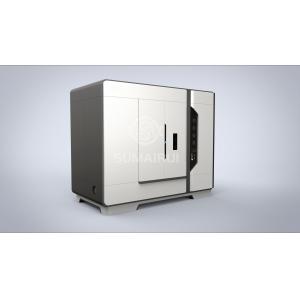

Add to Cart
OSL Series modular nitrogen generator for fiber laser cutting
industry with 20 cfm 99.99%-99.999% 500 psi 6000-30000W
Nitrogen production that is carried out using pressure swing
adsorption (PSA) technology over a carbon molecular sieve (CMS) is
considered to be a mature, cost-effective and highly efficient
method to produce nitrogen to meet a wide range of purity and flow
requirements. Ongoing increases in efficiency in PSA-based
nitrogen-generation facilities are being driven by enhanced CMS
materials (Figure 1) and process improvements. This article
provides an overview of the fundamentals of PSA-based nitrogen
generation, while focusing specifically on innovative practices and
improved CMS materials. Together, these advances contribute to
continuous improvement in PSA system performance, giving chemical
process industries (CPI) plant operators a proven way to produce a
reliable and low-cost supply of high-purity dry nitrogen onsite.
FIGURE 1. Carbon molecular sieve (CMS) pellets, typically manufactured from coconut shells, provide the surface area and pore structure needed to separate oxygen and nitrogen from a compressed air inlet stream
Nitrogen — in both the gaseous and liquid state — is used in a wide range of applications in many industrial sectors. These include the production of foods and beverages, chemicals and pharmaceuticals; petroleum processing; the thermal treatment of metals; the manufacture of flat glass, semiconductors and electronics; and many more. Industrial facilities that require large volumes of nitrogen always look for efficient methods of onsite nitrogen production to meet all of the specifications related to purity, flow requirements, power consumption, footprint and portability
Nitrogen gas is produced by separating air into its primary component molecules (nitrogen and oxygen), using one of two methods:
1. Traditional cryogenic fractionation of air that has been liquefied; or 2. Separation of gaseous air using pressure swing adsorption (PSA) or membrane-based separation systems. If large volumes of nitrogen with extremely high purity (99.998%) are required, cryogenic fractionation of air remains the most efficient and economical technology option
2 This is the oldest method of nitrogen production, and it has the ability to produce both gaseous and liquid nitrogen (for daily use and as a backup supply). Cryogenic fractionation of air is typically carried out in large-scale commercial plants that then deliver the produced nitrogen to users.
However, at many CPI facilities, enriched nitrogen is produced onsite using smaller-scale PSA separation or membrane-based separation systems. PSA systems operate on the principle of physical adsorption of the oxygen in air by carbon molecular sieve materials (such as those shown in Figure 1), leaving an enriched nitrogen stream as the product; the process is illustrated in Figure 2. Today’s PSA systems can economically produce nitrogen from compressed air at a variety of volumes. For instance, today’s systems can handle an inlet air stream of less than 5,000 to more than 60,000 std. ft3/h, reliably producing N2 that meets purity requirements from 95 to 99.9995%
FIGURE 2. Within the CMS pellets, oxygen is preferentially adsorbed, allowing a nitrogen-rich product stream to be captured for use onsite
However, the capital and operating costs of a PSA system are directly correlated with the purity of the nitrogen produced, and these costs climb rapidly once nitrogen with purity greater than 99.5% is required. In some cases, it can be cost-effective to produce higher-purity nitrogen by first producing 99.5%-purity nitrogen using a PSA system, and then using a palladium or copper unit to remove residual levels of oxygen in the nitrogen product. Such systems can bring down residual oxygen to 1–3 ppm.
SELECTING THE RIGHT SYSTEM
When selecting the most appropriate nitrogen-production process, several parameters should be considered. Purity and capacity are the most important factors that can affect the choice of production methodology, and hence, have a direct impact on the unit cost of the nitrogen produced. The use of a PSA nitrogen-generation system, which can be designed to meet all types and patterns of nitrogen flow — steady, periodic and erratic — has grown in popularity during the last several decades, thanks to the simplicity, performance, flexibility, reliability and relatively low capital and operating costs of this production route.
However, the optimal nitrogen-production rate using a PSA system based on CMS pellets is around 3,000 Nm3/h of N2 produced (>95% purity). Within that range, PSA is a more economical option than O2/N2-separation by air liquefaction and cryogenic separation, or by membrane-based separation. The principles of PSA-based nitrogen-generation technology using CMS and several important aspects of process engineering knowhow are discussed below.
CARBON MOLECULAR SIEVES
CMS is part of a special class of activated carbons that have non-crystalline (amorphous) structure with a relatively narrow pore-size distribution. This material provides molecular separations based on the rate of adsorption of nitrogen, rather than the differences in adsorption capacity between oxygen and nitrogen. Figure 2 shows the inner structure of a CMS material that is appropriate for the separation (removal) of O2 molecules from N2 molecules in the compressed-air inlet, to yield an enriched nitrogen stream (Note: Carbon molecular sieves are selective for oxygen, while zeolite molecular sieves are selective for nitrogen).
